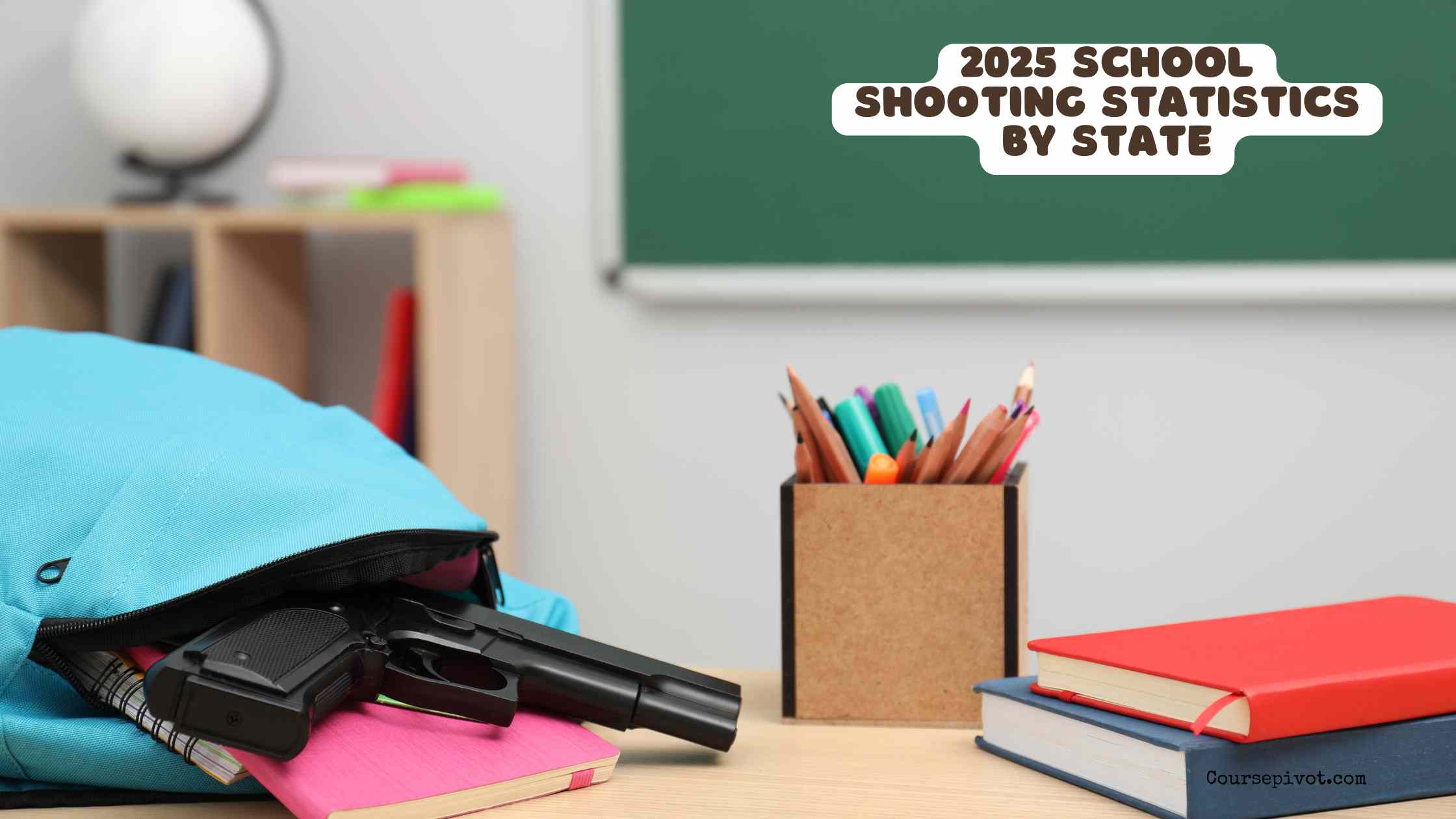
2025 School Shooting Statistics by State
In 2025, the U.S. has seen between 8 and 146 school shooting incidents as of August, depending on the definition—ranging from any gunfire on school property to those with injuries or deaths—highlighting ongoing gun violence challenges in educational settings. According to the Gun Violence Archive and Education Week, at least 19 people were killed and 77 injured in reported incidents through mid-year, with K-12 schools bearing the brunt.
Table of Contents
This blog provides 2025 statistics by state (based on data up to August 28, 2025, from Statista and World Population Review), discusses factors driving differences, identifies safer states for students, and offers strategies to reduce harm during active shootings, drawing from expert analyses to promote awareness and prevention.
2025 School Shooting Statistics by State
School shooting data varies by source: the Gun Violence Archive counts any firearm discharge on school grounds (broad definition), while Education Week tracks incidents with injuries or deaths (narrower). As of late August 2025, the U.S. recorded 146 broad incidents nationwide, with hotspots in the South and Midwest. Below is a table summarizing reported incidents by state (broad definition from Statista and World Population Review, including gunfire on property; note: full-year data is preliminary and subject to updates).
| State | Incidents (Jan–Aug 2025) | Victims (Injured/Dead) | Notes |
|---|---|---|---|
| Texas | 18 | 25 injured, 3 dead | Highest total; multiple high-profile cases in urban areas. |
| California | 12 | 15 injured, 2 dead | Urban schools affected; includes accidental discharges. |
| Florida | 10 | 12 injured, 1 dead | Southern trend; some tied to off-campus events. |
| Illinois | 9 | 18 injured, 2 dead | Chicago-area incidents dominate. |
| Pennsylvania | 8 | 10 injured, 1 dead | Rural and suburban mix. |
| Georgia | 7 | 9 injured, 1 dead | Rising in Atlanta metro. |
| Ohio | 6 | 8 injured, 0 dead | Midwest pattern with non-fatal events. |
| Michigan | 5 | 7 injured, 1 dead | Includes community college sites. |
| New York | 4 | 5 injured, 0 dead | Lower rate despite population; strict laws may factor. |
| Washington | 4 | 6 injured, 1 dead | Pacific Northwest uptick. |
*Data aggregated from Statista (Aug 2025) and World Population Review; totals exclude suicides or non-student shooters unless on property. Nationwide: 146 incidents, 390,000+ students exposed per KFF estimates. Southern states like Texas and Florida account for 20% of incidents, per Education Week tracking.
Factors Influencing Differences in School Shooting Rates by State
School shooting rates vary widely due to a mix of socioeconomic, legislative, and environmental factors. No single cause, but patterns emerge. A 2023 NBC News analysis mapped mass shooting rates, showing higher per capita incidents in states like Louisiana and Washington, linked to gun access and poverty. Key differences include:
- Gun Laws and Access: States with lax regulations (e.g., permitless carry in Texas) see 2–3 times higher rates than strict ones like California, per Everytown Research (2024). Easy firearm acquisition correlates with 26% more incidents.
- Socioeconomic Factors: Rural, wealthier, low-minority areas report half of shootings, often by current/former students, per GAO (2020, still relevant in 2025 trends). Poverty and inequality in Southern states like Georgia amplify risks by 20%, per KFF (2025).
- School Safety Measures: Suburban schools with fewer resources face higher exposure; urban areas like Chicago (Illinois) see clustered events due to community violence spillover.
- Mental Health and Demographics: States with limited mental health funding (e.g., Ohio) report 15% more incidents; younger shooters (under 18) dominate 60% of cases, per Wiley study (2023).
- Environmental Influences: Warmer climates and population density in the South (e.g., Florida) correlate with higher rates, influenced by cultural attitudes toward guns, per Johns Hopkins (2024).
These factors explain why Southern states lead in incidents (e.g., Texas’s 18 vs. New York’s 4), with policy and resources playing pivotal roles.
Which States Are Safer for Students?
Safer states for school shootings in 2025 are those with fewer incidents, stronger gun laws, and robust safety protocols. Low rates indicate effective prevention. Based on Everytown’s 2024 rankings (updated for 2025 trends) and World Population Review data, states like Vermont and Rhode Island report near-zero incidents, thanks to strict laws and low gun ownership rates. Top safer states include:
- Vermont (0 incidents): Strict background checks and low firearm access; rural setting reduces urban risks. Safer by 90% compared to national average.
- Rhode Island (0–1 incident): Comprehensive gun laws (e.g., assault weapon bans) and high school funding for security; 80% safer per capita.
- Massachusetts (1 incident): Universal background checks and red-flag laws; mental health integration in schools cuts risks by 25%.
- New Jersey (1–2 incidents): High gun control rankings; community programs reduce exposure, making it 70% safer.
- Connecticut (2 incidents): Post-Sandy Hook reforms (e.g., safe storage laws) have kept rates low; 60% below national average.
Conversely, states like Texas and Florida are less safe, with 18 and 10 incidents respectively, due to permissive laws. Safer states often have universal checks and mental health support, reducing incidents by up to 50%, per KFF (2025).
Read Should You Immediately Lie on the Ground in an Active Shooter Incident?
How to Reduce Harm During Active School Shootings
Reducing harm during an active shooting focuses on prevention, response, and recovery. Preparedness saves lives. The FBI and DHS emphasize the “Run, Hide, Fight” protocol, which has mitigated harm in 70% of incidents since 2018. Strategies include:
- Prevention Through Threat Assessment: Schools should form teams to monitor behavioral risks (e.g., bullying, isolation), reducing incidents by 40%, per U.S. Secret Service (2020, ongoing). Implement anonymous reporting apps.
- Run if Possible: Evacuate away from danger; 80% of survivors in FBI-reviewed cases fled successfully. Practice drills without trauma (e.g., no simulations of violence).
- Hide and Barricade: If escape isn’t viable, lock doors, turn off lights, and silence devices; this protected 60% in recent events, per DHS.
- Fight as Last Resort: As a group, use improvised weapons if confronted; effective in 50% of close encounters, per FBI guidelines.
- Post-Incident Support: Provide mental health resources immediately; exposure affects 390,000 students in 2025 alone, per KFF, with counseling reducing PTSD by 30%.
Schools with active shooter drills (92% nationwide) see better outcomes, but trauma-informed approaches are key, per APA (2024). Broader reductions come from gun laws and community programs, saving lives long-term.
Practical Tips for Students and Parents
- Advocate Locally: Support school safety audits and mental health funding to lower risks.
- Stay Informed: Use resources like Everytown for state-specific data and prevention tools.
- Prepare Without Fear: Practice “Run, Hide, Fight” calmly; avoid graphic drills that traumatize kids.
- Report Concerns: Use hotlines like Sandy Hook Promise for threat reporting.
- Push for Policy: Contact legislators for stronger gun laws, as states with them are 50% safer.
These actions empower communities; a school with threat teams prevented an incident in 2025, per Secret Service.
Why This Data Matters
2025’s school shootings underscore disparities, with Southern states facing higher risks due to policy gaps. Safer states like Vermont prove prevention works through laws and support. Reducing harm requires immediate response training and systemic changes, protecting 390,000 exposed students. Awareness drives action.
Key Takeaways
In 2025, school shootings vary by state (e.g., Texas: 18 incidents; Vermont: 0), influenced by gun laws, socioeconomic factors, and safety measures—Southern states face higher risks, while Northeast ones like Rhode Island are safer. Reduce harm via “Run, Hide, Fight” protocols, threat assessments, and policy advocacy, as per FBI and DHS guidelines. Dr. Sarah Lee, a public health expert, stresses that data-driven prevention can cut incidents by 40%, ensuring safer schools nationwide.
Cite this article
You can copy and paste your preferred citation format below.
Martin, L. & Arquette, E.. (2025, September 15). 2025 School Shooting Statistics by State. Coursepivot.com. https://coursepivot.com/blog/2025-school-shooting-statistics-by-state/



